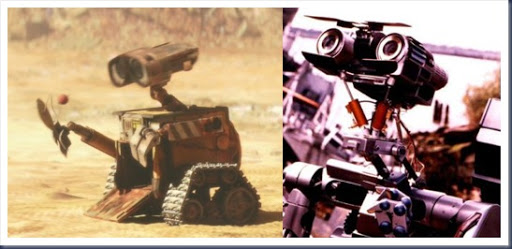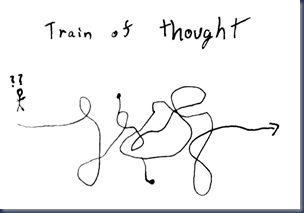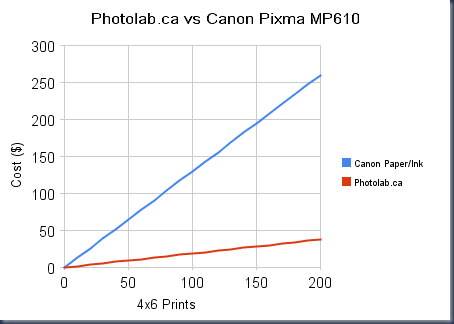This contains a few spoilers, but nothing that would completely ruin the movie for you if you haven't already seen it.
I saw WALL-E this weekend, and overall I thought it was pretty good. I'm a bit mystified by the torrent of comments up on Twitter and in the blogosphere saying it's perfect in every way, the best movie of the year, it's fantastic, etc. It's certainly a great movie, but I wouldn't put it in genius territory quite yet (maybe I need to watch it another time?). I thought The Incredibles and Ratatouille were a bit better overall - we'll get to the big reason why in a second.
I have to admit I really liked the undoubtedly intentional homage to Johnny 5's design (from Short Circuit, which was my favourite movie for a long time as a kid - you could tell even back then I'd become an engineer!). Also loved the Mac startup sound when WALL-E boots up, but that's been covered to death already.
Nitpicking
1) The passengers on the ship are referred to as "shoppers", which begs the question of how a population of 8-th generation travelers who don't seem to actually do any useful work can accumulate any assets to spend, and how those assets would have any value when the only trading partner is BNL. There appears to be a completely uniform distribution of "stuff" among the population, so there can be no interpersonal trade or bartering. How is the shipboard economy sustained? I would have loved to see a few hints on what their economy is like; as it is, I think we can just speculate and wait for the DVD with director's commentary. As an aside, I'm trying to think of examples in sci-fi literature of self-contained shipboard economies, and I'm coming up blank. I loved the ideas in Charles Stross' Accelerando, where the ship of (virtualized) explorers has no economy itself (the explorers and their physical environment being nothing more than a simulation), but the characters set up a kingdom which acts as a trust back in the originating solar system, tasked with making enough money to continue powering the ship remotely over decades.
2) Why are they throwing garbage out into space? It seems clear the Axiom ship, which has been out there for 700 years, is intended to function as a self-sustaining system, but if that's the case, they certainly can't afford to be throwing out materials at the rate at which we see them doing so during the movie. The movie does establish that the ship itself commands automated probes like the one that carried EVE, so perhaps we're meant to assume these probes also handle mining for raw materials.
3) The ship lands at the end of the movie, and in scale, it's clear it's much smaller than a large city (it looks like it might be a few kilometers long, if even that). So where is the rest of humanity? My assumption today is that somehow, the lifestyle that led to the extreme consumerism of the race and the destruction of the environment also caused a gradual contraction of humanity's numbers down to a couple thousand, who finally decided to evacuate when BNL provided the opportunity. Again, maybe I missed some key hints, but I didn't see this addressed.
4) How is it that even after seven centuries, atmospheric pollution hasn't died down? Part of the explanation could be that there's no vegetation to absorb any of it, but you'd think even then, over that length of time, the cycle of rain and evaporation would push it all down as water, and everything would end up in the oceans sooner or later, clearing the air. (But hey, what do I know about ecology, I'm a software guy. I'm sure over the coming days we'll get analysis by people who know how to answer this.)
WALL-E after the other Pixar masterpieces
My final gripe (all the above are just fun openings for speculation) is that the moralizing message in this one is quite a bit more blunt and in-your-face than it was in previous Pixar films. This is part of what made them charming, they weren't too blatant with their moralizing. Off the top of my head, I can think of a few 'lessons' imparted on the viewer by each movie, and there's always an obvious unoriginal one, as well as a less cliché secondary lesson. (Remember, this is just my opinion, and I certainly wasn't acing the literature and film analysis courses I took back when I was in school.)
Finding Nemo had the tired, obvious lesson of "you can do great things no matter who you are, accept yourself along with the small imperfections" (the whole misshaped fin thing). It had more interesting, less obvious lessons about the treatment of animals, their natural habitat, and the value of sticking together as a family.
The Incredibles had the best one: "When everyone's special, no one is". This one theme, with Syndrome's jealousy, is a terrific teardown of the stupid, broken, touchy-feely politically correct "everyone's a winner" style of educating kids where somehow, everyone ends up with a prize at the end. Life isn't like that. Your precious little snowflakes aren't all winners. I love that the writers had the guts to put in that line about everyone being special. Its secondary topic, I think, was an examination of what it means to have an unfulfilling life, and though I adored this movie as it is, I've always thought a slightly darker ending, where Bob Parr ends up forced to go back to just surviving in the shadows, would have been more fitting.
Ratatouille? A bit harder to analyze, actually, and it seems the harder the Pixar movies make it to identify their central themes, the better the movie ends up being. Ratatouille was, arguably, firstly about following your dream despite an unsupportive peer group (a bit similar to Nemo in that respect), and secondly about the art and enjoyment of food, and the evilness of commoditizing and commercializing food preparation. Mmmm, tasty. I'm still not sure how the critic fits in.
Finally, we get to WALL-E which is the one I'm most likely to get wrong, because although I've seen The Incredibles something like 8 times, I've seen WALL-E but once. WALL-E hits you over the head with an unsubtle full-throated shout of "stop consuming / wasting so much", etc, etc. I thought showing the indoctrination of newborns in the school/nursery was quite nice ("B is for BNL, your very best friend"), but it was so brief it may whizz right by the youngest children in the audience [this isn't really a criticism, given my opinion about the film's lack of subtlety].
The deception and poor planning on the part of the BNL CEO ("stay the course!") were likewise enjoyable, but not particularly clever or restrained. Showing the human race as lazy, unthinking pleasure-seekers is also in many respects apt, but at this point it's a smidgen tired and overused. (Though WALL-E did it better than Idiocracy, I must say.) The other part of the story worth talking about is the (extremely cutely done) love between WALL-E and EVE, which has the novel property of unfolding between robots, but once more it's a familiar archetype: the dumpy, ugly guy falls in love with the hopelessly beautiful and refined female character who has no interest in him. He persists and eventually gets the girl - big surprise.
It's certainly worth the 10$. Go see it, then come back and comment. I'm looking forward to seeing it another time, and hoping to go "OH! Of course! How stupid I've been!", and changing my opinion about all the above.

![CropperCapture[240]](http://lh4.ggpht.com/jpdaigle/SFwGmnKRiuI/AAAAAAAAAiQ/4fkzW5ppek4/CropperCapture%5B240%5D_thumb%5B2%5D.png)
![CropperCapture[241]](http://lh4.ggpht.com/jpdaigle/SFwGoPszzEI/AAAAAAAAAiY/X8Lu__wo2ew/CropperCapture%5B241%5D_thumb%5B2%5D.png)



